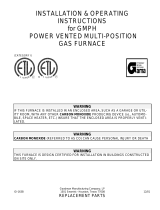
3
AVERTISSEMENT :
N’installez pas cette fournaise si l’une de ses
pièces a été immergée dans de l’eau. Une
fournaise endommagée par une inondation
est extrêmement dangereuse. Toute tentative
d’utiliser la fournaise peut entraîner un incendie
ou une explosion. Il faut communiquer avec un
organisme de service qualifié pour l’inspection de
la fournaise et le remplacement de toutes pièces
électriques ou parties du système de commande
qui ont été mouillées ou immergées.
CAUTION:
Operating gas furnaces in construction
environments can cause a variety of problems
within the furnace and may significantly
reduce the life or the performance of the
furnace. Therefore operating the furnace during
construction is not permitted and will void the
warranty.
REQUIREMENTS & CODES
• This furnace must be installed in accordance with
these instructions, all applicable local building codes
and the current revision of the National Fuel Gas Code
(NFPA54/ANSI Z223.1) or the Natural Gas and Propane
Installation Code, CAN/CSA B149.1.
• Use only with type of gas approved for this furnace.
Refer to the furnace rating plate.
• Install this furnace in accordance to the minimum
clearances to combustible materials listed in Table 1,
(page 5).
• Provide adequate combustion and ventilation air to the
furnace space as specified on page 5. Do not block
or obstruct air openings on the furnace, air openings
to the area where the furnace is installed, or the space
around the furnace.
• Combustion products must be discharged outdoors.
Connect this furnace to an approved vent system, as
specified on page 9.
• Never test for gas leaks with an open flame. Use
a commercially available soap solution to check all
connections. See page 16.
• This furnace is designed to operate with a maximum
external pressure rise of 0.3 inches of water column.
NOTE 1: The static pressure measurement should not
include the coil (if applicable). Consult the rating plate
for the proper circulating air flow and temperature rise.
NOTE 2: It is important that the duct system be designed
to handle the desired flow rate and external pressure
rise. An improperly designed duct system can result in
nuisance shutdowns, and comfort or noise issues.
• When supply ducts carry air circulated by the furnace
to areas outside the space containing the furnace, the
return air shall also be handled through the front door
of the furnace. Make sure there is sufficient return air
through the door. See return air connections page 6.
• Additional information listed below is for reference
purposes only and does not necessarily have jurisdiction
over local or state codes. Always consult with local
authorities before installing any gas appliance.
Combustion & Ventilation Air
• US: National Fuel Gas Code (NFGC), Air for Combustion and
Ventilation
• CANADA: Natural Gas and Propane Installation Codes
(NSCNGPIC), Venting Systems and Air Supply for Appliances
Duct Systems
• US and CANADA: Air Conditioning Contractors Association
(ACCA) Manual D, Sheet Metal and Air Conditioning
Contractors National Association (SMACNA), or American
Society of Heating, Refrigeration, and Air Conditioning
Engineers (ASHRAE) Fundamentals Handbook
Electrical Connections
• US: National Electrical Code (NEC) ANSI/NFPA 70
• CANADA: Canadian Electrical Code CSA C22.1
Gas Piping & Gas Pipe Pressure Testing
• US: NFGC and National Plumbing Codes
• CANADA: NSCNGPIC
General Installation
• US: Current edition of the NFGC and the NFPA 90B. For
copies, contact the National Fire Protection Association Inc.,
Batterymarch Park, Quincy, MA 02269; or American Gas
Association, 400 N. Capitol, N.W., Washington DC 20001 or
www.NFPA.org
• CANADA: NSCNGPIC. For a copy, contact Standard Sales,
CSA International, 178 Rexdale Boulevard, Etobicoke
(Toronto), Ontario, M9W 1R3 Canada
Safety
• US: (NFGC) NFPA 54–1999/ANSI Z223.1 and the Installation
Standards, Warm Air Heating and Air Conditioning Systems
ANSI/NFPA 90B.
• Federal Manufactured Home Constructions & Safety Standard
(H.U.D. Title 24, Part 3280.707[a][2])
• The Standard for Manufactured Home Installations
(Manufactured Home Sites, Communities, and Set-Ups) ANSI
A225.1 and/or CAN/CSA-2240 MH Series).
• American National Standard (ANSI-119.2/NFPA-501C) for
all recreational vehicle installations.
• CANADA: CAN/CSA-B149.1 and .2–M00 National Standard
of Canada. (NSCNGPIC)
• The Commonwealth of Massachusetts requires
compliance with regulation 248 CMR 4.00 and 5.00 for
installation of through – the – wall vented gas appliances
as follows:
1. For direct-vent appliances, mechanical-vent heating
appliances or domestic hot water equipment, where the
bottom of the vent terminal and the air intake is installed
below four feet above grade the following requirements
must be satisfied:
a.) A carbon monoxide (CO) detector and alarm shall be
placed on each floor level where there are bedrooms.
The detector shall comply with NFPA 720 (2005
Edition) and be mounted in the living area outside
the bedroom(s).
b.) A (CO) detector shall be located in the room that
houses the appliance or equipment and shall:




















